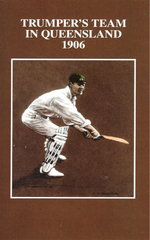Trumper’s Team in Queensland 1906
Martin Chandler |Published: 2012
Pages: 116
Author: Hawkins, John
Publisher: Christopher Saunders Publishing
Rating: 4 stars

There is that iconic photograph that George Beldam took of him jumping out to drive. His name sounds as if it has come straight from a novel written by a member of the Bronte sisterhood. There was also a tragically early death. Such factors help but cannot alone explain why Victor Trumper’s name continues to resonate down the generations. Almost a century after his passing there are no rheumy-eyed old men left who saw him play. There are no moving pictures to evidence his technique. Yet interest in the man and his achievements, and most of all the style and grace of his batting, remains undimmed.
It was 1964 before the first book devoted to Trumper appeared and, to demonstrate his universal appeal, that was published in India of all places, but it was a collection of essays and not a biography as such. We had to wait until 1978 for former Australian opening batsman Jack Fingleton to plug that particular gap in the game’s literature. During the 1980s former Test off-spinner Ashley Mallett and sporting historian Peter Sharpham then each produced their own life of the great man.
Unsurprisingly there have been no more full length biographies of Trumper but writers and publishers have found him difficult to resist. Lancastrian cricket historian Gerry Wolstenholme wrote a book about him in 2002, more particularly a match at Blackpool in 1909 in which he scored 150 in less than two hours. Christopher Saunders has published a lavish reproduction of his photograph album from that 1909 tour (he has also produced a limited edition statuette modeled on Beldam’s photograph) and now he has published John Hawkins account of a tour by a team that Trumper led around Queensland for a month in April and May of 1906. Ten matches were played, two against a Brisbane XI, and the others all against odds. None of the fixtures has ever had First Class status although Trumper’s men were all First Class cricketers. That said apart from their captain only pace bowler Tibby Cotter and all-rounder Bert Hopkins ever played Test cricket.
In the context of the overall history of the game the tour is not an important one. Trumper’s side were not unduly tested by the Queenslanders. The opposition in Brisbane seems to have been very weak, and must have been expected to be stronger than it proved to be Trumper’s team did not however quite have things all their own way. They came very close to being defeated in the third match of the tour against a North Queensland XIII.
So what of Hawkins’ book? The most interesting aspect of the tour is why it took place at all. In the 21st century the concept of a leading player taking a team on a private tour to one of the game’s lesser centres is an unknown one, so this is a timely reminder of the somewhat haphazard way in which cricket developed in Australia from the days when only Victoria, New South Wales and South Australia were powers in the land. Years ago Hawkins was fortunate enough to acquire at auction Trumper’s original contract, and the early part of the book sets the scene for the account of the tour that follows.
There are some pen pictures of the participants, the longest inevitably being that of Trumper. These short biographies are well written, although there is a curious comment in that of Cotter. I have read elsewhere that he died in his trench while serving in Palestine in the Great War in 1917 when he suddenly stood up and was shot by a sniper. Quite how Hawkins is able to go on to say that the reason he rose was because he could not believe what he saw through his periscope has had me scratching my head ever since I read it. There is a first ever biography of Cotter due soon – perhaps it will provide me with an answer.
As is only to be expected of a tour book the bulk of the narrative is taken up with accounts of the ten matches, sympathetically reconstructed from contemporary reports, followed by some statistics and what amounts to a post-tour review. The book then concludes with a beautifully reproduced facsimile of a 24 page contemporary brochure which, it goes without saying, is exceptionally rare and correspondingly difficult to acquire.
Trumper’s Team in Queensland 1906 is not going to be a bestseller, if for no other reason than it has been produced in a signed and numbered limited edition of just 150 copies, but it is a delightful book for the connoisseur, and is highly recommended. Copies are available direct from the publisher at the, all things considered, modest cost of GBP20 plus shipping.






Leave a comment